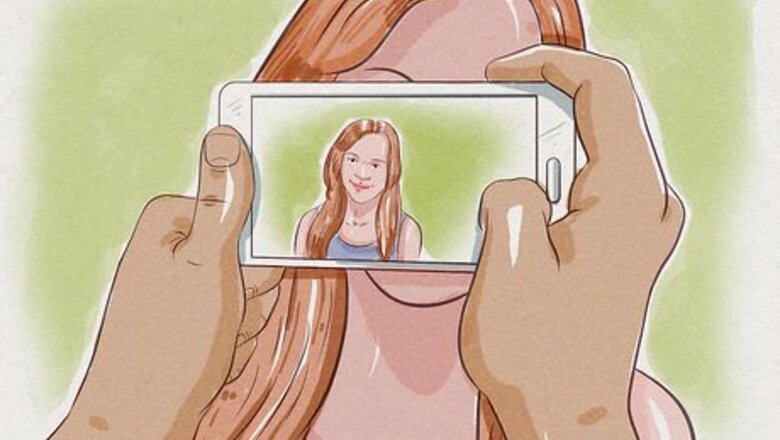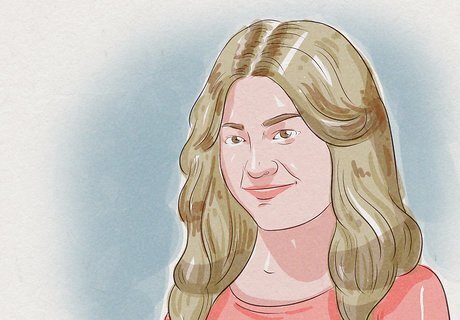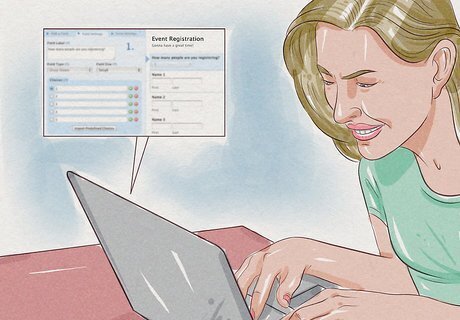
views
Creating a Portfolio

Use amateur photos. It's really not worth the extra cost to get professional pics done. Get a friend or relative with a smart phone or standalone camera and let them take a number of photos of you. It's best to keep the setting fairly basic with a single-color backdrop, almost like a passport photo. Pose for a large number of shots, at least twenty, so that you'll have plenty to choose from. Out of these photos, you'll need to select between six to twenty images to include in your final portfolio. You'll need a wide range of photos, including at least one head shot. Avoid having anything distracting in the background of your photos, such as random household objects. For example, it's better to stand in front of a blank wall instead of one filled with framed portraits. If you've done professional freelance modeling work in the past, you may need to get permission from the photographer or client to use these photos. Once you have this permission, go ahead and include those shots in your portfolio.

Attach a video. If you plan to send in your portfolio electronically, it's a good idea to include a sixty-second video. In the video, quickly introduce yourself and discuss your modeling background. Zoom the camera out, so that the scouts will be able to see your body. Try not to put on a show and just behave naturally.

Keep all photos recent and accurate. Your photos don't need to be from the past six months, but they should accurately reflect your current appearance. If you've lost or gained more than a few pounds, then get another set of photos done. Make sure to include photos that reflect the current length of your hair as well.

Include only high-quality photos. The pics should be clear and crisp without any blurriness. The shading and lighting should draw attention to your best attributes and minimize any flaws. Any colors should appear vibrant and bright. Get your photos printed on good photo paper as well. It's probably best to take them to a photo shop to be printed, instead of doing it at home. If your portfolio is digital, you can maximize photo quality by using a camera set to the highest pixel level with the least compression. You can also spend some time editing your images using professional software, such as Photoshop.

Include some headshots. Most agencies will want to see close photos of your face taken from a number of angles. This is especially important for print or fashion models. Keep any make-up very minimal for these shots, so that the recruiters can see the quality of your skin. Vary your expressions and smile in at least one shot. A good general rule is to include more smiling shots if you are looking for commercial work. Use the least amount of make-up that you are comfortable with. This could mean just applying a bit of concealer, light powder, mascara, or lipstick. The recruiters will want to see the condition of your skin. Wear your hair down in your headshot.

Put in at least one full-body shot. For these images, choose clothes that show off your body's best attributes. If you are aiming for a high-fashion agency, then a shot in swimwear can also be useful. As you choose outfits, think about how your choices will let recruiters see how clothing fits you. Again, don't feel as if you have to wear super fancy or high-fashion outfits in every shot. It's better to keep it basic, so recruiters can see your potential. Go with solid colors and simple prints. Only wear one 'statement' item at a time, such as a unique piece of jewelry. For example, if you are apple-shaped, then draw attention upwards by wearing an interesting necklace or turtleneck. Or, if you have an hourglass figure, cinch in your waist with a fashionable belt. Try to keep your pictures simple. For example, a simple photo could be a photo of you with no filters in good lighting.
Submitting Your Application

Target a market that fits your look. Consider your body type, physical appearance, and interests as you choose what type of modeling to pursue. High-fashion models, for example, are often tall and lean. Athletic models are generally muscular.

Find reputable agencies. Go online to the websites of the various agencies and look at their current model rosters. See if you can envision yourself working alongside them. Check to see that the agency has been in business for at least ten years. Research their client lists to see if they cater to companies that interest you. Agencies of all sizes are usually actively recruiting for new models throughout the year. If you work with a smaller agency, you may get more personal attention. But, a larger agency may be able to provide more consistent work.

Look up agency submission details. Go to the agency's website and read through their submission guidelines. Some agencies require that you mail all materials in, whereas others give you an electronic submission option. Follow all of their directions down to the last detail. If they ask for a certain size image, then make sure to send it along.

Type up a stats page. This is a page that includes all of your measurements, such as height, weight, bust, hips, waist, cup, dress, shoes, suit size, and inseam. Many models also list their hair and eye color as well. It's a good idea to place your name in bold at the very top. You could also include a small headshot image in an upper corner.

Send all of your materials in one package. In your portfolio, include a brief cover letter of introduction, your professional resume, your stats page, and all of your photos. Organize your photos so that the best one appears first. Place these items in a slim, secure binder. Do not include all of your rejected or “extra” images within your binder. Keep your cover letter short and to the point. Introduce yourself, explain your interest in modeling, and tell them what you've sent along. For example, you might write, “I started my freelance modeling career at the age of six, but would like the consistency of working with an agency.”
Schedule an in-person interview. If the agency looks through your portfolio and is interested, then they will likely call you with the offer of an in-person interview. That is why it's best to apply to agencies locally unless you are willing to travel. For most interviews, you'll simply talk to a representative for thirty minutes to an hour, but they may also want some test shots.
Finding Modeling Work in Other Ways

Build up your online following. Social media is a very important tool that you can use to show off your relevance and popularity. After you've applied to agencies, focus some of your energies on going to local modeling events, making friends, and then connecting with those friends online. Post interesting photos of yourself on Instagram and you might even draw additional agency interest. Create additional connections by commenting on the posts of other models and responding to comments posted on your page. Social media is a popular place to get scouted. Gigi Hadid Gigi Hadid, Model & Fashion Influencer Modeling takes practice and hard work. "When I started, I was the worst on the runway. I try to keep learning every time I step off a runway and get better with each one. I have mentors that have taught me, and I’m still trying to get better today."

Go to an open casting call. Check agency websites for the details of open casting listings. This is where you'll bring your portfolio and wait with many other aspiring models to talk with casting agents. The agents will conduct a brief interview, snap a few photos, and get in touch if they are interested. This is a great opportunity to give casting agents a taste of your unique personality and to make a memorable impression. For example, you might show them a (flattering) photo from one of your recent hiking adventures. Aside from your full portfolio, it can be helpful to create a laminated composite card to hand out. This card will contain a small photo, your name and contact information, and your relevant stats.

Join a modeling club. Many large universities and cities have clubs that aspiring models can join, usually for a small fee. These clubs spread the word about opportunities and are a great way to learn more about particular agencies and the industry on the whole. If you are a younger model, you might also find a mentor within a club. Some modeling clubs are simply informational, whereas others may hold public fashion shows and practice shoots.

Beware of potential scams. There are a number of dishonest people and companies preying on hopeful models. Watch out for modeling schools or agencies that request a payment in advance. An agency's fees should generally only occur when you are working. Also, steer clear of any persons or companies that request risqué or nude photos, as this is not the policy of established agencies.













Comments
0 comment